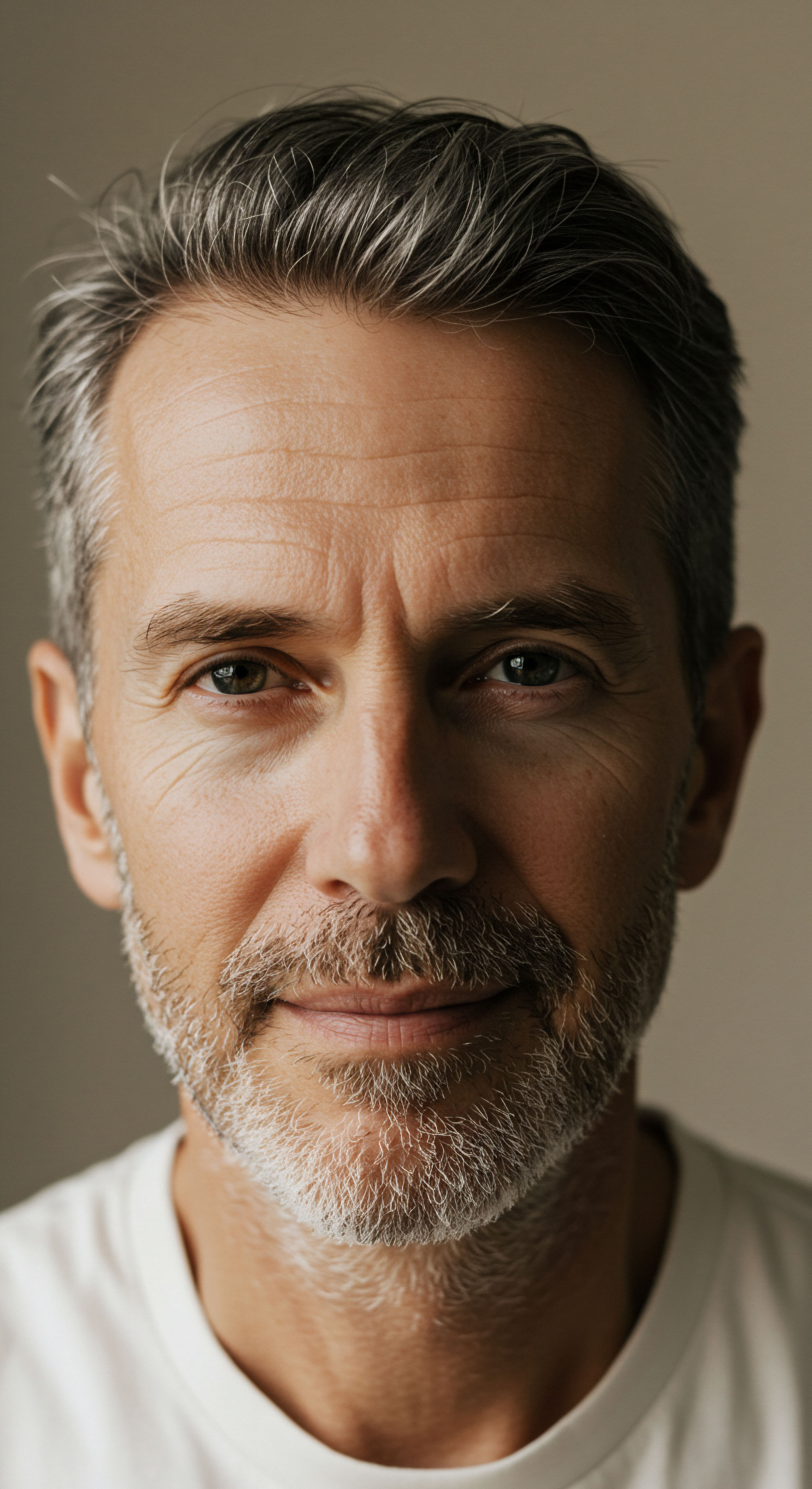

Your Calendar Age Is an Illusion
The number of candles on your birthday cake is a footnote in your body’s story. That number, your chronological age, simply marks the passage of time. Your biological age, however, articulates the true state of your cellular performance. This is the metric that dictates the body’s functional state, its resilience, and its vitality, determined by molecular and physiological markers.
A person can be 45 years old by the calendar but possess the cellular machinery of a 35-year-old. The reverse is also true. This divergence is not a matter of luck; it is a direct reflection of accumulated cellular damage and genetic expression, profoundly influenced by lifestyle, environment, and proactive choices.
Understanding this distinction is the foundational step in taking control of your performance trajectory. Biological age is a stronger predictor of health outcomes and mortality than chronological age. Individuals who are biologically older than their years face substantially higher risks for age-related conditions.
This metric, therefore, is not a passive number but an active signal. It is a data point that reveals the precise operational efficiency of your internal systems. Viewing aging through this lens moves it from a passive process of decline to an active system that can be measured, understood, and recalibrated.
Recent studies show that biological age is a stronger predictor of health outcomes, including mortality in critically ill patients.
The architecture of your vitality is written in your cells. The length of your telomeres ∞ the protective caps on your chromosomes ∞ and the patterns of DNA methylation across your genome are the core biomarkers of this internal clock. Telomeres shorten with each cell division, acting as a countdown timer for cellular senescence.
Epigenetic clocks, conversely, measure chemical modifications to your DNA, which dictate which genes are turned on or off. These markers provide a high-resolution snapshot of your body’s true operational age, offering a roadmap for targeted intervention. Recognizing biological age permits more accurate risk assessment and personalized care, allowing for interventions that target the aging process itself.


Recalibrating Your Cellular Clock
Your biological age is a dynamic system, not a fixed state. It responds to targeted inputs. The core mechanism for measuring and influencing this metric lies in understanding and optimizing your epigenome, specifically through DNA methylation. Think of your DNA as the body’s master blueprint.
DNA methylation is the series of annotations and instructions written on that blueprint, directing which parts of the code are read and when. These instructions are not permanent; they can be revised. An epigenetic clock, like the one developed by researcher Steve Horvath, analyzes the methylation patterns at hundreds of specific sites on your DNA to calculate your body’s functional age with remarkable accuracy.
This process gives us a quantifiable target. By influencing the factors that direct DNA methylation, we can begin to edit the instructions, prompting our cells to express a younger, more vital phenotype. This is not about simply masking the signals of aging. It is about rewriting the script at a cellular level.
A strategic protocol focuses on a collection of inputs known to positively influence these epigenetic markers. A groundbreaking 2021 clinical trial demonstrated that a specific 8-week program of diet and lifestyle interventions could reduce biological age by an average of over three years. This provides a clear precedent for the power of targeted, systems-based interventions.

The Core Optimization Protocol
A protocol for recalibrating biological age is built on several key pillars, each designed to send specific signals to your cellular machinery. These inputs work synergistically to adjust epigenetic expression and support the body’s innate maintenance systems.
- Targeted Nutritional Inputs. The diet in methylation-supportive programs is rich in compounds that act as “epinutrients.” These are specific vitamins and phytonutrients that are known to donate or support the body’s use of methyl groups, the fundamental units of DNA methylation. A 2023 case series in women reinforced the findings from the earlier study in men, showing significant biological age reduction through a diet and lifestyle program designed to support DNA methylation.
- Optimized Physical Stressors. Exercise is a powerful epigenetic modulator. Specific protocols, including both high-intensity interval training and resistance training, have been shown to stimulate AMPK, a critical pathway for cellular energy regulation and mitochondrial biogenesis. This sends a clear signal for cellular renewal and efficiency.
- Intelligent Recovery Architecture. The body recalibrates during rest. Prioritizing sleep hygiene is a non-negotiable component of any age optimization strategy. During deep sleep, the body clears metabolic waste, consolidates memory, and repairs cellular damage. Chronic sleep disruption accelerates epigenetic aging.
- Hormonal and Peptide Recalibration. For some individuals, optimizing the endocrine system is a powerful lever. Hormone replacement therapy (HRT) can restore youthful signaling patterns. Specific peptides can also be used to provide targeted instructions for cellular repair and regeneration, essentially acting as high-level foremen for the body’s construction crews.
The process begins with a baseline measurement. A blood or saliva sample is used to establish your initial biological age via an epigenetic clock. This provides the key biomarker to track progress against. The subsequent protocol is then tailored to your unique physiology and goals. Progress is monitored through periodic re-testing, allowing for adjustments to the protocol to maximize its efficacy. This data-driven approach removes the guesswork and provides clear, quantifiable feedback on the impact of your interventions.


The Moment of Activation
The time to engage with your biological age is the moment you decide that your current trajectory is insufficient. It is for the individual who senses a decline in performance ∞ be it cognitive, physical, or aesthetic ∞ and seeks a proactive, systems-based path to optimization.
This is not a protocol for managing decline; it is a strategy for engineering a superior state of being. The initial signals may be subtle ∞ a persistent brain fog, a slowdown in recovery after exercise, or a change in body composition that is resistant to previous methods. These are not inevitable symptoms of aging; they are data points indicating that your biological systems are operating at a suboptimal level.
The decision to act is a shift from a passive acceptance of chronological aging to an active engagement with your biological potential. It is relevant for the 40-year-old executive seeking to maintain a cognitive edge, the 55-year-old athlete wanting to extend her competitive window, or any individual who wants their internal state to match their ambition.
The “when” is less about a specific chronological age and more about a mindset. It is the point at which you choose to become the architect of your own vitality.
A groundbreaking clinical trial shows we can reduce biological age by more than three years in only eight weeks with diet and lifestyle through balancing DNA methylation.
The results of a targeted intervention protocol can manifest on multiple timelines. Within the first eight weeks, as demonstrated in clinical trials, significant shifts in epigenetic markers can occur, leading to a measurable reduction in biological age. This initial phase is characterized by tangible improvements in energy levels, cognitive clarity, and physical recovery.
Over the subsequent months, these changes compound. You may notice enhanced resilience to stress, improved body composition, and a more robust immune response. Long-term, the sustained practice of these principles aims to compress the period of morbidity at the end of life, extending your healthspan and ensuring that your later years are lived with the same vitality and purpose as your prime.

Your Biology Is a Verb
The most profound shift in modern wellness is the understanding that our biology is not a static noun, but a dynamic verb. It is a continuous process of becoming, a system in constant dialogue with its environment. The tools to measure and direct this process are no longer theoretical; they are available and validated.
Engaging with your biological age is the ultimate act of personal agency. It is the decision to move from being a passenger in your own body to being the pilot, using precise data to navigate toward your desired destination. The future of performance is not about accepting the limitations of the calendar. It is about understanding the code of your own vitality and having the courage to rewrite it.

Glossary

cellular performance

biological age

dna methylation

epigenetic clock

hormone replacement therapy

with your biological




